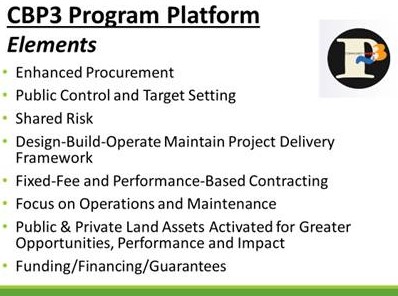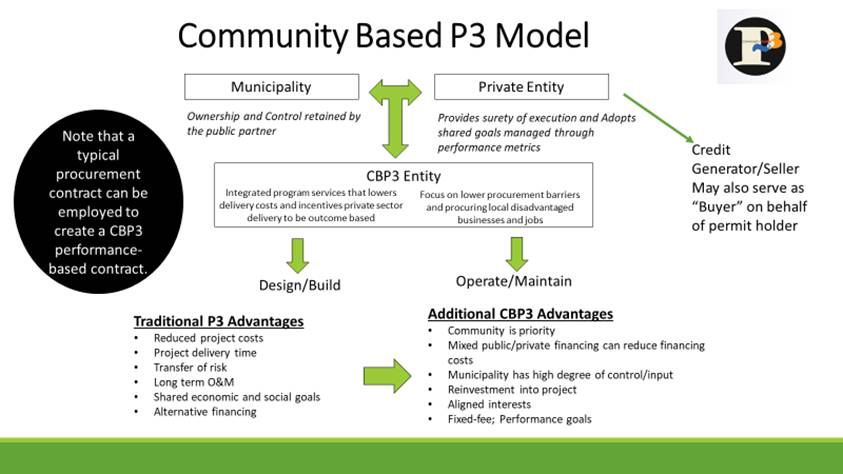- See Press Release on CBP3 Center Launch
- See Information on CBP3 Community Tech Support
- See EPA Resources on CBP3s
The Community-Based Public-Private Partnership (CBP3) Center for Water, Energy and Equitable Economic Resilience:
A Center of Excellence of the National Municipal Stormwater Alliance (NMSA)
 The Community-Based Public-Private Partnership (CBP3) Center for Water, Energy and Equitable Economic Resilience (“CBP3 Center of Excellence”), a Center of Excellence of the National Municipal Stormwater Alliance (NMSA) has been established to promote the CBP3 program approach for the benefit of communities across the U.S. The CBP3 program approach was developed by the U.S. EPA to help communities accelerate environmental infrastructure investments in a more efficient and cost-effective manner and to provide a framework that maximizes the benefit to local workers and small and minority-owned businesses. Just as important, this new and innovative approach provides a platform for long-term and large-scale infrastructure investing that can leverage funding and financing options providing the best deal for the community, whether that be through public or private sources.
The Community-Based Public-Private Partnership (CBP3) Center for Water, Energy and Equitable Economic Resilience (“CBP3 Center of Excellence”), a Center of Excellence of the National Municipal Stormwater Alliance (NMSA) has been established to promote the CBP3 program approach for the benefit of communities across the U.S. The CBP3 program approach was developed by the U.S. EPA to help communities accelerate environmental infrastructure investments in a more efficient and cost-effective manner and to provide a framework that maximizes the benefit to local workers and small and minority-owned businesses. Just as important, this new and innovative approach provides a platform for long-term and large-scale infrastructure investing that can leverage funding and financing options providing the best deal for the community, whether that be through public or private sources.
First applied in Prince George’s County, Maryland in March, 2014 through engagement with EPA Region 3, the results of the CBP3 program approach have shown to be conclusive in the ability to meet and exceed project delivery pace and cost savings as well as local jobs and business establishment and utilization goals. Several other communities across the country have followed suit and are now leading or developing similar programs that are tailored to the community’s needs. One example is the City of Chester, Pennsylvania, which launched a CBP3 in 2018. A summary of the status and accomplishments of the Chester CBP3 program is provided at this case study summary document. Information developed and compiled by U.S. EPA on the CBP3 program approach can be found here.
The CBP3 Center is established as a resource for communities struggling to address challenges associated with urban runoff and compounded by the impacts associated with climate disruption. Also, the Center recognizes the significance of the water-energy nexus and equitable economic opportunities, and that these are important for resilient communities along with the potentiality of circular solutions that support holistic and sustainable growth. The focus of the Center on green stormwater infrastructure (GSI) is based upon the ability to leverage the multiple benefits associated with GSI as it is integrated into other infrastructure sectors, such as transportation or public parks, to drive increase value.
Investments to treat water quality and manage localized flooding over recent decades have had mixed results. The limited effectiveness in stormwater management has resulted in increases in impacts associated with harmful algal blooms, flooding, and other water quality and quantity issues. The overall result of these impacts is growing threats to public health and safety, reduced resilience, and significant economic losses. Worse yet, these impacts are unevenly distributed such that disadvantaged communities, who are already suffering in many aspects, experience the brunt of stress and loss associated with environmental degradation and vulnerable infrastructure systems. The dynamics of continued urbanization along with climate change will exacerbate these impacts even further, especially for communities of color and other marginalized communities.
To date, the level of investment to address urban runoff impacts has been limited due to several factors. A lack of funding available to localities is a clear challenge; however, another factor that is even more significant is the traditional design-bid-build (DBB) approach to project delivery that is the status quo way to implement stormwater management projects. Unlike other types of infrastructure, stormwater infrastructure – especially GSI – is decentralized and requires many installations to address the runoff in a jurisdiction or watershed. The status quo DBB project delivery method is ill suited to major investments in stormwater. The result of this status quo are inflated costs for project delivery as well as limited project delivery volume done a relatively slow pace.

A new way to implement stormwater infrastructure – especially GSI – has been developed that proposes a different approach that seeks to implement GSI in an efficient manner that is integrated into the broader infrastructure landscape, which is a contrast to the slow, costly, isolated, piecemeal and inefficient paradigm of status quo project delivery of GSI. This approach – the Community-Based Public-Private Partnership program approach – breaks through these inefficiencies by integrating planning, design, and construction services into one performance-based program that is defined and led by a public-sector partner – the community. Further, this approach aligns interests of the public and the private parties by utilizing a full-delivery fixed-fee project delivery approach that also includes targets to utilize local small, minority-owned businesses as well as local/community workers.
The CBP3 program approach is defined as an arrangement seeking to deliver large volumes of high-value infrastructure using a project delivery approach that reduces costs and increases the pace of implementation while also generating maximum benefits to local communities in terms of economic activities and social benefits. This approach also seeks to utilize the least-cost funding and financing options, such as Clean Water State Revolving Fund assistance, to limit the financial burden on communities with the flexibility to integrate other funding and financing options – public or private – that can meet the spirit of the CBP3 program approach.
A tactic central to this approach is to unlock synergies between a variety of infrastructure sectors for outcomes that drive cost efficiencies and mutual benefits. Investments in GSI in transportation right-of-way that can reduce harmful pollutants and minimize runoff and localized flooding could also be used to off-set runoff-generated impacts from privately-owned parcels nearby. Other options include GSI implemented in a public park to provide aesthetic and urban cooling as well as water quality and quantity services or GSI implemented to enhance local groundwater resources and reduce the need for pumping of water from outside sources, which consumes significant energy.

The CBP3 Center will enumerate the principles of the CBP3 program approach and ensure that this approach is applied in a manner consistent with these principles. The CBP3 Center also promotes the application of CBP3 arrangements through the development and delivery of educational products and programs, support of federal/state/local advocacy activities, and engagement with communities through direct outreach and technical support focused on various aspects of the CBP3 program approach. The Center is developing a CBP3 Leadership Advisory Team, which is chaired by Dominique Lueckenhoff, Senior Vice President for Corporate Affairs & Sustainability, Hugo Neu Corporation, working with the Center Director, Seth Brown, PE, PhD, who also acts as NMSA Executive Director.
The Center is currently focused on growing a community of practice with existing CBP3 practitioners. The Center will continuously revisit and adapt the strategic mission to ensure that activities and products associated with the Center are relevant to the changing dynamics of infrastructure priorities and needs.

Questions on the CBP3 Center should be sent to Seth Brown at: seth.brown@nationalstormwateralliance.org.
